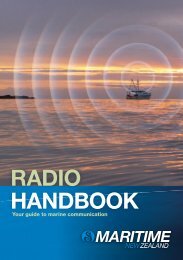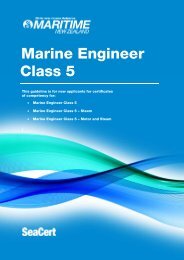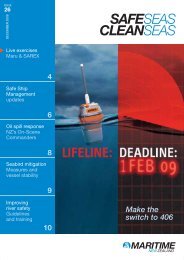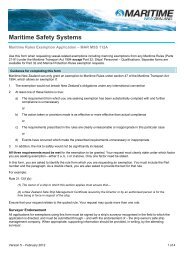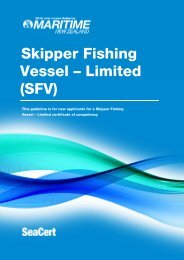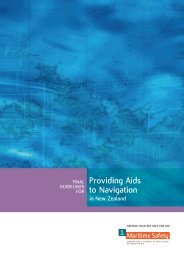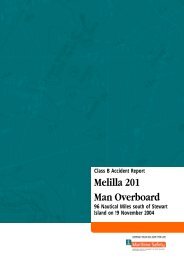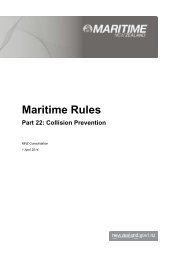You also want an ePaper? Increase the reach of your titles
YUMPU automatically turns print PDFs into web optimized ePapers that Google loves.
Delayedreaction togas escapeA shore maintenanceengineer working on a fishingvessel’s refrigeration systemwas overcome by freon gaswhich escaped whilst purgingpressure from the lines.The engineer had worked withoutincident on the lines system over theprevious two days, as part of the generalrepair, cleaning and maintenance processon the vessel. On the day of the accident,the engineer was intending to inspect thethermo expansion valves fitted to the ceilingpipe evaporator coils. The engineerunscrewed the liquid line of the firstvalve and left it to purge off any residualpressure without any difficulty. However,as he started to disconnect the secondline, the valve opened suddenly and blewout under great pressure and landed onthe deck of the fish hold. Some liquid,but mainly refrigerant gas, then started toescape from the line for around 10 to 15seconds. On hearing the noise of the gasescaping, the skipper and crew of thevessel rushed to the fish hold to checkthe source of the noise. At that stagethey were unaware the shore engineerhad been working in the hold. When theysaw the engineer in the fish hold, theskipper called out to check if he was OK,and received a ‘thumb’s up’ signal. Theskipper and crew then left.After the gas had stopped ventingfrom the line, the engineer got down onhis hands and knees to search for themissing valve opening. After he retrievedit and stood up, he suddenly felt verywoozy and disoriented. He tried to makefor the hatch ladder and leave the hold,but collapsed before he could do so.About fifteen minutes later, when theskipper was on the deck of the vessel, heHe tried to makefor the hatch ladderand leave the hold,but collapsed beforehe could do so.heard the sound of groaning coming fromthe bottom of the fish hold. On investigation,the skipper saw the engineer lying onthe deck of the hold with his legs pulledup into his chest. The skipper and one ofthe crew immediately climbed down intothe fish hold and brought the engineerup on deck, put him in the recoveryposition and called an ambulance. Theengineer began vomiting, but after aboutThe vessel.10 minutes in the fresh air, he began tofeel better. He had no memory of whathad happened. He was later dischargedfrom hospital without any ill effects.It was estimated that about 10kg offreon gas had escaped into the fish hold.View the full report online at:www.maritimenz.govt.nzLookout!PointsToo closefor comfort!Two passenger ferriescame within around 0.3nautical miles of eachother in a close quartersencounter during a crewtraining exercise.About three nautical miles from land andheading seaward, the master of the firstferry decided to drill officers and crew onthe use of the emergency steering system.The master, first officer, first engineeringofficer and several deck crew gatheredin the steering compartment, while thethird officer and a deck cadet kept watchon the bridge. Before the drill began,the bridge crew noted the presence ofthe second ferry on a broadly reciprocalcourse about 10 nautical miles off. Thevessels were closing with each other at acombined speed of about 35 knots.The master of the first ferry decidedto conduct the emergency steeringgear drill using the manually operateddirectional control valve, instead of theusual non follow-up switch. Neither themaster, nor any of the crew had practisedthis method on the vessel before.Despite some disquiet from the ferry’sengineer, the master alerted the bridgevia telephone the steering control wasabout to be transferred from the bridgeto the steering gear compartment andthat the vessel would then be turningto starboard. By now the second ferrywas about three nautical miles out andbearing on the port bow. The bridge crewdid not mention this to the master.Once the steering had been transferred,one of the crew, on the instructionsof the master, operated the directionalcontrol valve marked “starboard”. Thebridge crew immediately noted that insteadof the vessel turning to starboard asthey had been told would happen, it hadin fact started to turn to port, and in thedirection of the approaching ferry. Theyinstead of thevessel turning tostarboard as theyhad been told wouldhappen, it had infact started to turnto port, and in thedirection of theapproaching ferry.looked at the rudder angle indicator andnoticed that port helm had been applied.The bridge crew did not immediatelyalert those in the steering compartmentof what was happening assuming theywould soon realise their mistake.The second ferry was now about onemile away and bearing fine on the portbow. As the first ferry was still turning toport, the bridge crew advised the masterthat the rudders had gone to port andemphasised that starboard helm wasneeded. However they still did not mentionthe near approach of the other ferry.The master again called for starboardhelm, and the same valve as beforewas operated but this time with a largeramount of what was wrongly assumed tobe starboard helm. Seeing the rudders goto port again, the bridge crew alerted themaster for the first time of the developingclose quarters situation with the otherferry and asked for the steering controlto be returned to the bridge. The mastercalled for the helm to be set amidships,but was told it had stuck. The first ferrywas by now swinging rapidly to port inthe direction of the second ferry.Realising there was a problem,the master of the second ferry immediatelyput his helm hard to starboard toturn away.After the steering control wasreturned to the bridge, the bridge crewarrested the port swing and brought thevessel back on track. The second ferry,which closed to within approxiamately500 metres of the first ferry, continuedto turn away until well clear.It was later discovered that the firstferry’s port and starboard directionalcontrol valves had been labelled in thereverse direction.View the full report online at:www.maritimenz.govt.nz1. Whilst the employers of the engineerstated they had robust health and safetyprocedures in place for working in isolationin enclosed spaces, the engineer, asa minimum, should have informed thecrew of his intentions so that one of themcould have been standing by in the eventof an emergency. If the skipper had notheard the engineer groaning, the situationcould have been very serious indeed2. Although the fish hold was not in thestrictest sense, an enclosed space, suchas a cargo tank or a double bottom tank,the open hatch cover was not very largeand the following precautions shouldhave been taken:■ Before commencing work on the ship’srefrigeration system, where gas couldpotentially escape, a permit to workshould have been obtained.■ A portable gas detector should havebeen used before starting any work.■ A ready means of communicationshould have been established throughoutthe time the engineer was in thefish hold.■ A safety belt/harness line should havebeen rigged in readiness should anemergency occur.■ A breathing apparatus set should havebeen immediately available for use by arescuer in the event of an emergency.3. When the gas first started to escape,the engineer should have left the hold.Freon gas is heavier than air and thedecision of the engineer to search forthe valve on his hands and knees seriouslyincreased the risk of his exposureto the fumes.4. The skipper and crew member shouldnot have gone into the hold to retrievethe engineer without first checking thatthe hold was gas free or without usingbreathing apparatus sets. By failing to doso they put their own lives at risk.It was later discovered that the ferry’s portand starboard directional control valves hadbeen labelled in the reverse direction.1. No crewmember had experienceusing the manually-operated directionalcontrol valves on the first ferry. The masterdid not carry out a thorough pre-drillbriefing, outlining what to expect and thesafety actions to be taken should theybe required.2. The bridge watch crew did not impressupon the master the pending approachof the second ferry until a close quarterssituation had already developed. Careshould have been taken before commencingthe drill to ensure that no other vesselswere likely to be in the near vicinity.Lookout!Points3. The master who was conducting theemergency drill did not report this incidentto <strong>Maritime</strong> NZ, even though it was clearlyreportable under the provisions of the<strong>Maritime</strong> Transport Act. The master of thesecond ferry later reported the incident. LOOKOUT! JULY <strong>2006</strong>LOOKOUT! JULY <strong>2006</strong>





